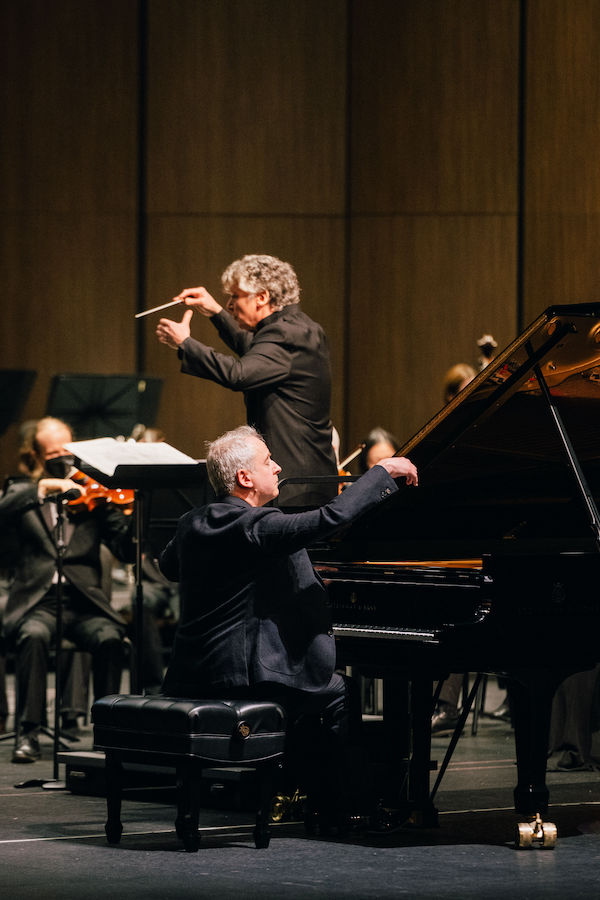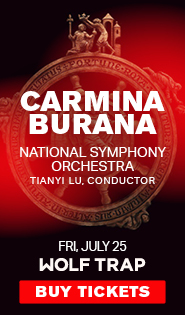Fairfax Symphony opens anniversary season with romantic blockbusters

Jeremy Denk performed Brahms’ Piano Concerto No. 2 with Christopher Zimmerman conducting the Fairfax Symphony Orchestra Saturday night. Photo: Lock & Company.
The Fairfax Symphony Orchestra opened its 65th anniversary season Saturday night, with a special appearance at Capital One Hall. One year ago the ensemble christened this new venue, located in a high-rise building in Tysons, in a similar kind of program with a high-profile soloist.
They returned this time with pianist Jeremy Denk, in a concert combining two musical juggernauts, one concerto and one symphony, composed within two decades.
The orchestra invited Dalia Palchik, an elected official from the Fairfax County Board of Advisers, to conduct the season-opening national anthem. Music director Christopher Zimmerman dedicated the concert to the memory of the late William Hudson, the former music director who led the FSO for over half its existence. He also congratulated Emile “Mickey” Zimmerman, the FSO’s first concertmaster, now 95, who still attends every concert.
With the official business over, Jeremy Denk took the stage as soloist in Brahms’ Piano Concerto No. 2, a massive combination of symphony and concerto, even longer than the Sibelius symphony on the second half. Calum MacDonald has suggested viewing this concerto “as a kind of pianistic autobiography—by a composer for whom the piano, and piano music, lay at the center of his creativity.” Tellingly, Brahms dedicated the piece to his piano teacher, Eduard Marxsen.
Denk sees the piece in a similar light, having been obsessed with it since the age of 12, as he has written in his recent memoir, Every Good Boy Does Fine. The signature horn solo that opens the first movement came off solidly, although there were significant problems when that musical idea reappeared later in the movement. Denk wove the piano part around this horn theme with wonder and grace.
Denk’s efforts were strongest at such moments, as he applied his chamber music skills to interacting with various sections or instruments of the orchestra. He displayed admirable fortitude bringing together the part’s many challenges, succeeding best in its subtleties. While the first movement hung together well, the Scherzo roiled with conflicts, mostly having to do with the tempo, not always agreed upon between the orchestra, Zimmerman, and Denk.
By contrast the third movement shimmered with poetry, opening with an understated rendition of the extended cello solo from principal cellist Marion Baker. This movement is the most confessional for Brahms, perhaps inspired to include this cello solo by the memory of the slow movement of the teenage Clara Schumann’s Piano Concerto. Brahms eventually adapted the melody as a song, “Immer leiser wird mein Schlummer” (My Slumber Grows Ever More Peaceful), setting a poem by Hermann Lingg, full of potential personal relevance.
Denk excelled in the longing piano response to this music, leaning on the tender appoggiaturas as if lost in thought. Later in the movement, Denk spun a contemplative web around the paired clarinets sighing in thirds. Brahms borrowed this twilit music from his own song “Todessehnen” (Yearning for death), whose text is also weighed down with significance. The carefree Finale swept away these heavy thoughts, with Denk again and again urging the orchestra on to faster and faster tempi.
Sibelius’s First Symphony is a work that seemed just as personal to its composer. The first movement opened with a mournful clarinet melody, rendered moodily by principal Giancarlo Bazzano over a tense timpani roll. This tune incorporates a four-note motif that moves one step down, back to the same note, and then up one note. The gesture is the same as the grupetto, a musical ornament written like an “S” lying on its side. Finnish musicologist Harri Miettunen has identified it as the S-motif, something like a musical signature meaning Sibelius.
Zimmerman led a strong performance of the symphony, with solid contributions from the low brass at the climaxes. The coda of the first movement featured an ethereal moment for harpist Madeline Jarzembak, and more critical rolls from timpanist Jonathan Milke. The second movement spotlit lush string sound in the main theme, hovering over a long E-flat pedal, with solid woodwind contrapuntal lines in some of the faster variations.
As in the Brahms, fitfully sloppy ensemble unsettled the fast Scherzo movement. With more insecurity in the horns, the unusual Trio of this movement never quite coalesced into the mysterious thing it is meant to be. The Finale, a strange conglomeration of musical ideas Sibelius subtitled “quasi una fantasia,” returned to that S-motif theme from the first movement, now in a solemn, tragic light. Here the playing went better and, even in the ultra-fast fugal section, the FSO musicians sounded well-drilled, playing with crisp efficiency.
The Fairfax Symphony returns to George Mason University’s Center for the Arts for their annual Nutcracker with the Fairfax Ballet December 17 and 18. fairfaxsymphony.org

